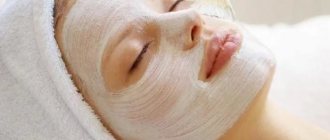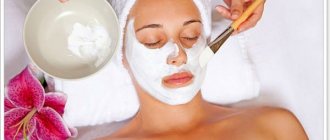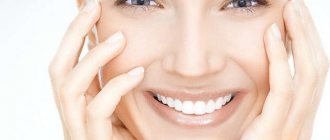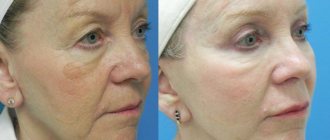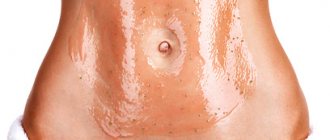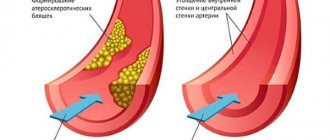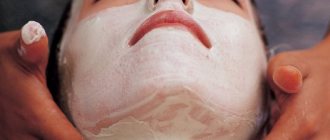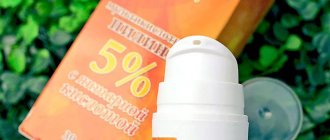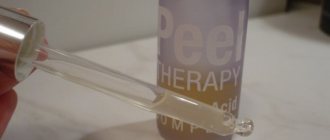Having decided to undergo the procedure, you need to pay attention to the composition of the drug. Sometimes manufacturers, in an effort to enhance its effect, add other substances to it. They can have a negative effect on the epidermis. For example, a high concentration of glycerol leads to skin dehydration. Burns are possible, so when applying peeling, you must strictly follow the protocol. Those women who decide to do peeling at home should be especially careful.
The only drawback of lactic acid is that it cannot eliminate serious age-related changes.
Properties of lactic acid
Cosmetics manufacturers often use lactic acid (lactate) in cosmetics. It has a keratolytic effect (exfoliation), moisturizes and improves skin tone, has a sebum-regulating, bactericidal and anti-inflammatory effect.
Lactate is formed as a result of the breakdown of glucose and belongs to the category of α-hydroxy acids. When the substance gets on the surface of the skin, the process of exfoliation of its top layer starts. Thanks to this, it becomes soft and tender. After penetrating into the mouths of the sebaceous glands, lactate dissolves accumulated dirt, epithelium and cosmetic residues. This allows you to eliminate blackheads and avoid the development of inflammation. Lactic acid also contains lactathione, a natural antiseptic that slows down the proliferation of pathogenic microorganisms.
Lactic acid penetrates deeply into cell membranes and promotes the uniform distribution of active substances that nourish the skin from the inside. It is sometimes added to homemade nourishing masks for the face and body. But here it is important to maintain the correct concentration. The acid content in the mask should be minimal. But for peeling, a highly concentrated composition is used. It is absolutely safe for the skin.
Among the beneficial properties of lactic acid are:
- Stimulating active renewal of dermal cells;
- Acceleration of collagenase processes (formation of new collagen fibers);
- Improving blood circulation in the area of cosmetic procedures;
- Whitening areas of pigmentation;
- Moisturizing the upper layers of the skin;
- Activation of the epidermis’s own protective properties.
Cosmetic line TianDe
Tiande is an international brand that has established itself in the beauty industry. It is a collection of cosmetics developed on the basis of recipes of ancient oriental medicine and at the same time incorporating the latest developments of scientists.
The Tiande brand produces more than 500 types of products, which include face, body, hair care products, decorative cosmetics, peelings and much more. The main producers are quite large state-owned enterprises in China, which have international quality certificates.
Here is one of the products from this company: Universal peeling “Milk”.
- It contains: protein, vitamin complex, whole milk and alpha hydroxy acids.
- This product helps to effectively cleanse the skin, improve blood circulation and metabolic processes.
- Whitens, evens out the overall skin tone, nourishes, moisturizes, returns natural color and increases skin elasticity.
Cost: 240 rubles.
Advantages and features of peeling
Milk peeling Argipeel (Argipil) is suitable even for the most sensitive skin. But this is far from the only advantage of this procedure:
- The recovery period is minimal; there will be virtually no signs of peeling on the surface of the skin after the procedure;
- Lactic acid does not cause allergies in the patient, the only exception may be its individual intolerance;
- Peeling is allowed even in summer;
- No preliminary preparation is required, just cleanse the skin of impurities and you can begin the procedure;
- Peeling additionally moisturizes the skin and makes it more elastic;
- The procedure is safe even for dark skin; no special care products are required.
Lactic acid goes well with other ingredients. If necessary, a cosmetologist can individually select a peeling composition that will transform it from superficial to medium. This means that not only the top layer of skin - the dermis, but also the epidermis will be exposed.
The only drawback of milk peeling is its low effectiveness for mature skin.
Stages of carrying out in the salon
If you want to not only get rid of oily skin, but also achieve a lifting effect, it is recommended to undergo an exfoliation procedure in the salon. This will protect against overdose and reduce the risk of adverse reactions.
Step-by-step implementation of professional milk peeling:
- Makeup removal, cleansing and degreasing of the skin.
- Toning with a product containing low fruit or lactic acid.
- Apply the exfoliant in several layers, leaving 1-2 minutes between them.
- Neutralization of acid composition (if necessary).
- Rinsing off solutions, drying the skin.
- Applying a soothing cream or mask.
The percentage concentration of peeling depends on the desired result and can vary from 30 to 90%.
When applying the acid composition, it is very important to follow the correct sequence: forehead, temples, cheeks, neck, décolleté, chin, area around the mouth, nose. Neutralization of the exfoliant is carried out in the opposite direction.
Cost of the session and full course
Milk peeling is quite affordable. One session in a Moscow clinic will cost an average of 3,000–3,500 rubles.
To achieve the most lasting result, it is necessary to carry out a full course of cleansing, consisting of 8–10 procedures. This means that you will have to pay 24,000–35,000 rubles for all treatment.
Indications for the procedure
Milk chemical peeling is recommended for patients under the age of 35-40 years.
Indications for the procedure include:
- Unhealthy, dull complexion;
- Freckles and mild age spots;
- Acne and hyperkeratosis;
- Excessive secretion of sebum from the pores;
- Small expression wrinkles in the area around the eyes or mouth;
- Enlarged pores;
- Fresh stretch marks;
- Dry and dehydrated skin.
Milk peeling is often used as a preliminary preparation for other cosmetic procedures. It is optimally suited for the face and décolleté; on other parts of the body it can be used as an effective remedy in complex therapy against scars.
How to peel with lactic acid
No special preparation is required for peeling. But it is recommended to limit exposure to the sun 2 weeks before the procedure - do not sunbathe. For patients with pronounced skin problems and very delicate skin, a cosmetologist may recommend daily use of a cream containing lactic or fruit acid.
The peeling procedure consists of the following steps:
- The skin is cleansed of impurities and decorative cosmetics. A special lotion is used. The skin is disinfected. To soften exfoliated particles of the epidermis, a small amount of the drug with the active ingredient in a minimum concentration is applied to the skin.
- Concentrated lactic acid is applied in two stages. It should remain on the surface of the skin for 10 to 40 minutes. The concentration of the drug is selected individually depending on the type of cosmetic problems and the general condition of the patient’s skin. Sensitivity and skin type are also taken into account.
- The cosmetologist must monitor the progress of the procedure. If the slightest signs of burns appear, the solution is immediately neutralized. If there are no side effects, it is possible to use more concentrated solutions during the next peeling. Peeling does not cause pain; the maximum that can be felt is a slight burning sensation in the first minutes after applying the acid.
- After the scheduled time, the drug is washed off from the skin. A moisturizing composition is applied to it; this can be a well-proven alginate mask. After its removal, the skin is treated with a nourishing cosmetic cream.
A repeat session of the procedure can be performed after 14-20 days.
Results and recovery period
The results of Argipil peeling, if performed by an experienced specialist using professional preparations, are visible almost after the first session:
- Small wrinkles on the skin are smoothed out;
- Age spots and freckles become dull and are no longer so pronounced;
- The skin looks healthier and more hydrated, no trace of dryness remains;
- The natural complexion returns, a slight lifting effect is observed;
- If there are post-acne spots on the skin, they are even in shade with other skin;
- Sebum production decreases significantly.
The first few days after a superficial peel, the skin may experience slight redness. During this period, the epidermis actively exfoliates; visually it is almost imperceptible, but a slight itching may be felt. It is advisable to give up not only decorative, but also skincare cosmetics for these few days. You can use various creams or lotions only after consulting a cosmetologist.
You should not use strong products for washing for about 4-5 days after peeling with lactic acid. They can provoke skin inflammation, which will be associated with the entry into the pores of aggressive chemicals that are part of most types of antibacterial soap.
Before going outside, especially if you plan to spend a long time in the sun, you need to use sunscreen. Avoid visiting solariums, saunas and public swimming pools where aggressive chemicals are used to purify the water.
What to expect after exfoliation?
If you choose milk peeling for your face, then you need to know what will happen to you after the procedure. In the first days after peeling, the skin will peel off a little. This is absolutely normal. You should not expect much peeling, since the effect is superficial.
Facial redness may be present, but not longer than 2 days. The feeling of warmth and slight burning should go away immediately after neutralization. If this does not happen, consult a doctor - you may have an allergic reaction.
Among the complications are:
- allergic reaction
- chemical burn.
By adhering to the following recommendations, you will make the milk peeling procedure as effective and safe as possible:
- if after applying the composition to the skin you feel discomfort or burning, then blowing cold air from a hairdryer will alleviate the condition;
- to protect the delicate skin around the eyes and lips, lubricate it with Vaseline before the procedure;
- be sure to watch the time, do not over-expose the composition;
- It is necessary to rinse off only with cool water;
- as a moisturizer after the main stage, choose creams with retinoids;
- the first session should begin with a minimum concentration, the concentration can be gradually increased;
- Do not comb skin that has been treated with acid;
- It is better not to use decorative cosmetics for 2 days;
- avoid sun exposure.
If you follow all the recommendations and advice of a cosmetologist, the milk peeling procedure will be successful, will bring only positive results and will not cause complications.
Contraindications
Argipeel peeling should not be carried out during periods of exacerbation of chronic or inflammatory diseases. It is prohibited for diagnosed oncology. It is recommended for pregnant and nursing mothers to temporarily postpone the procedure.
Other contraindications to superficial peeling include:
- damage to the skin at the site of the procedure;
- herpes;
- rosacea;
- lactic acid intolerance;
- taking antibiotics.
You should not do the procedure in the first week after hair removal. Some of the described contraindications are relative. Patients with herpes may be allowed the procedure, but before it they will have to take a course of antiviral drugs. The decision on the advisability of peeling in the presence of certain contraindications is made exclusively by a cosmetologist.
To obtain a lasting result, it is recommended to undergo 4-5 peeling sessions. The intensity and duration of the skin healing course is determined by the cosmetologist during an individual examination of the patient. Make an appointment with specialists at the Absolut Med Aesthetic Medicine Clinic right now!
Possible side effects
After the milk peeling procedure, the following consequences may appear:
- Slight exfoliation of the skin in the first 2-4 days after the procedure.
- Minor redness that goes away without intervention within two days.
- A feeling of burning and warmth during the procedure, which goes away already at the stage of neutralization and moisturizing.
- Patients with thin, sensitive skin may experience increased sensitivity. Shea butter and Panthenol will ease the condition.
- Burns due to violation of peeling technique or lack of awareness about the drug from this company. Testing the skin's reaction to acid is recommended. Panthenol and Olazol are used for treatment.
